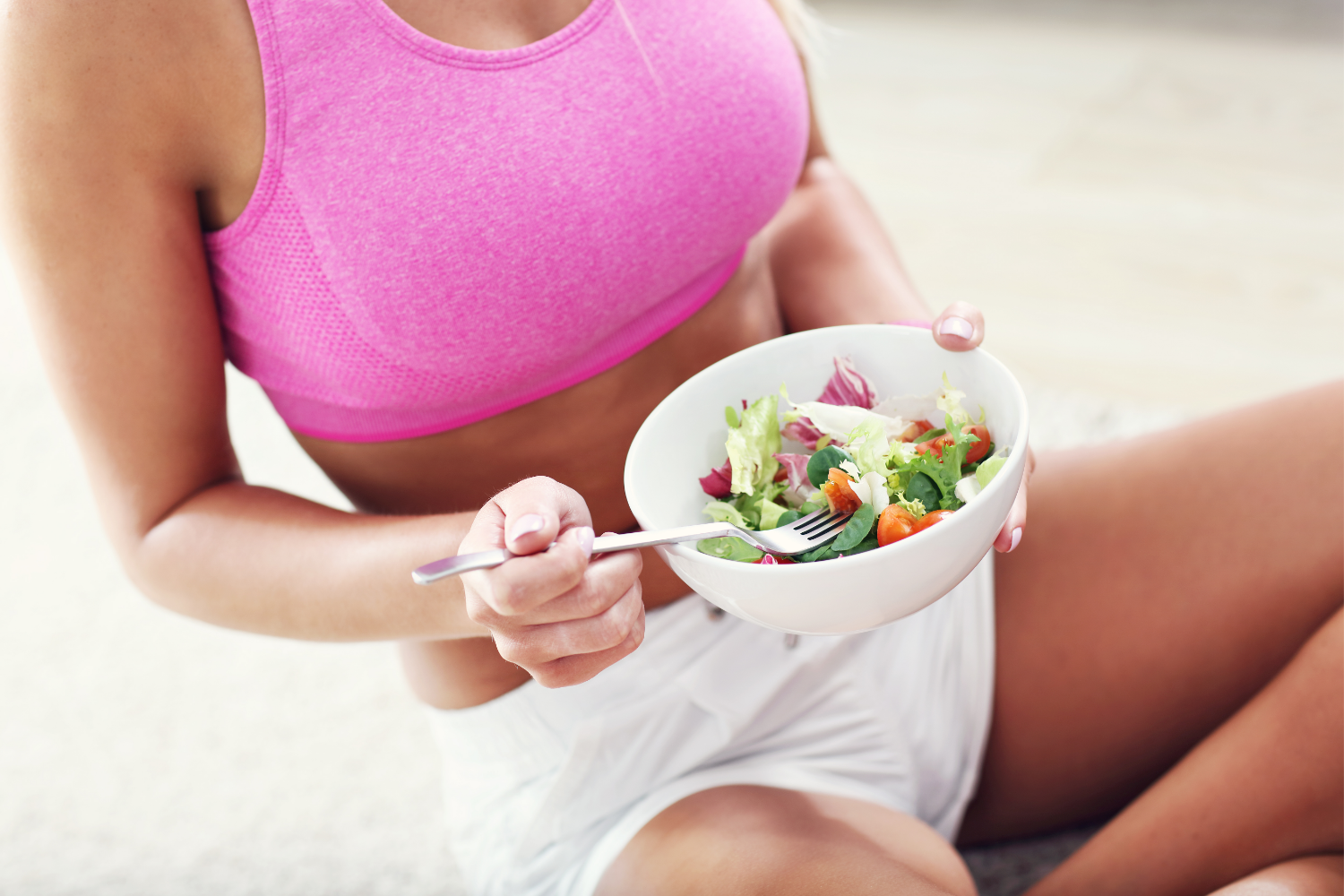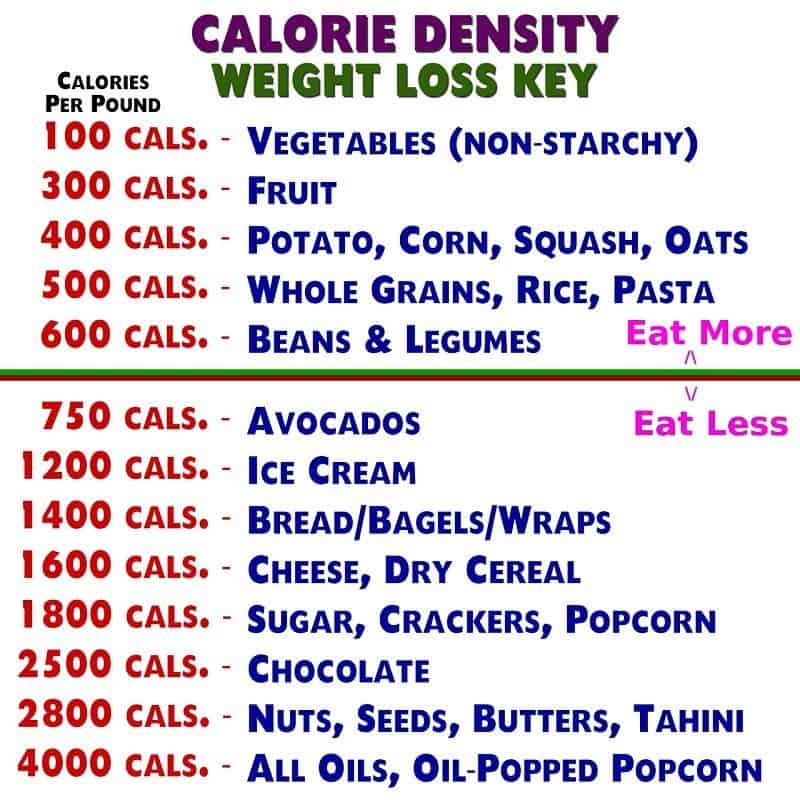After being plant-based for 5-years, I can confidently say this is the easiest, fastest, and healthiest approach to sustainable weight loss. The research I have studied on the many weight-loss approaches, explains why plant-based diets continue to blow the rest out of the water. Let’s take a look at the essential guidelines for plant-based eating, and why these promote healthy weight-loss and maintenance.
A whole-foods plant-based diet is the fastest, easiest way to lose and maintain a healthy weight throughout one’s lifetime. You don’t have to sweat your life away at the gym, and there is no need to uncomfortably restrict calories when you are eating foods consistent with your biology.
In this article we will get you started by covering the following:
- First and foremost, stick with whole foods
- Focus on foods with a low-calorie density
- Using the principle of calorie density to lose weight
- How calorie density is important for satiety (feeling full)
- How nutrient density plays a role in satiety
- Sample 7-day plant-based meal plan for weight loss
There are so many purported diets, diet books, weight-loss gurus, and diet supplements on the market today. How are consumers going to weed through all the bogus claims and false remedies to find true health and stable weight loss? Fortunately, the solution is easily accessible and it doesn’t come with any fads or gimmicks.
First and foremost, stick with whole foods
It is critical to include the “whole-foods” specification when discussing a diet consisting entirely of plant food substances. Technically, an unspecified plant-based diet could easily consist of potato chips, soda, vegan ice-cream, and candy.
Why is this important for weight loss? The more a food is altered from its original form the more you increase its calorie density. Let me say that one more time. The more processed a food is the greater the amount of calories it contains.
For example, wheat is about 500 calories per pound, while whole-grain wheat bread is 1,200 to 1,500 calories per pound. You will find similar outcomes when converting any grain into a more processed form. As you can see in the table below, whole brown rice is about 500 calories per pound, while brown rice flour converts to about 1500 calories per pound.
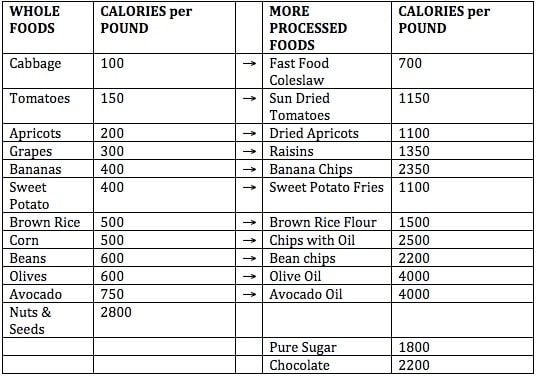
So what is going on during the processing that leads to this three-fold increase in calories? Every step taken in the processing of a given food increases its surface area creating a more readily absorbed nutrient. The more work spent mechanically stretching and pulverizing that grain of wheat into flour, the less work your body has to do to metabolize it.
Now, I’m not saying you can never eat processed foods. What I am saying is that the more your diet consists of whole intact foods the faster you will lose and maintain a healthy weight.
Focus on foods with a low-calorie density
My favorite aspect about a plant-based lifestyle is that all the food options are incredibly low in calories, and thus, you can eat much larger quantities! Basically, when adopting this diet you will eat more food but fewer calories. Who doesn’t want that?!
Just so we are all on the same page, calorie density is the calorie content of a given food relative to its weight. This measurement is typically expressed as calories per pound.
For example, non-starchy vegetables have the least calorie density with 100 calories per pound. At the opposite end of the spectrum, we have oils that provide a whopping 4,000 calories per pound, as seen in the list below.
Using the principle of calorie density to lose weight
This chart shows a great comparison of the calories per pound you can expect to gain by eating foods from plant-based categories vs the more processed or animal-based foods. So, how do we use this knowledge to our advantage to lose weight?
Easy! Start by sticking with foods above the green line, (as displayed in the chart above) until you have reached your ideal weight. Then slowly start to incorporate some of the richer (more calorie-dense) foods below the green line.
Re-introduce these richer foods slowly by using small amounts at a time. This will allow you to carefully observe how fast your weight will fluctuate when certain foods are re-added to your diet.
When your weight starts increasing to an undesirable level, simply dial back on the rich foods. That’s really all there is to it!
If your desire is to be whole-foods plant-based (WFPB), then be sure to choose those items instead of the more processed or animal-based options. The WFPB categories above the green line are the non-starchy vegetables, fruit, starchy vegetables, whole grains, and legumes.
You can eat as much of these foods as you like without ever needing to worry about calorie content because they are so low in calorie density.
High-calorie dense plant foods
You may have noticed that there are some plant-based whole foods below the green line in the chart above. More specifically, I’m referring to avocados, nuts, and seeds. These are extremely healthy plant-based foods. They just happen to also be extremely calorie-dense.
Some people choose to only eat the lower calorie-dense WFPB options, i.e. the veggies, fruit, starches, grains, and legumes. There are slight metabolic differences among people that have been predetermined by your genetics. Some people can eat handfuls of nuts each day without gaining a pound. Others can’t even look at a nut without gaining a couple of pounds practically overnight.
Just so we’re clear, I am not suggesting you need to count calories. You will never need to keep track of your calories when you are eating whole plant foods. I’m simply providing a word of caution when it comes to these high-calorie dense plant foods.
How calorie density is important for satiety (feeling full)
Satiety, or feeling satiated, basically means you feel you have had enough to eat and you are no longer hungry. Now, what is most helpful about calorie density is how it induces feelings of satiety by acting directly upon the stretch receptors in your stomach.
Let’s use the most extreme example of calorie density again to explain what occurs in the stomach when you eat 500 calories of oil vs. 500 calories of veggies. 500 calories of oil is about 4 tablespoons of oil. 4 tablespoons is not going to fill much of your stomach. This will, in turn, leave your stomach growling for more food even though you have just consumed about 500 calories.
500 calories of non-starchy vegetables, on the other hand, may not even fit in your stomach. You will inevitably feel satiated because 500 calories of veggies will trigger your stretch receptors. This will signal to your brain that you have had enough to eat, and therefore, will no longer feel hungry. Take a look at the depiction below to get a visual for this example.
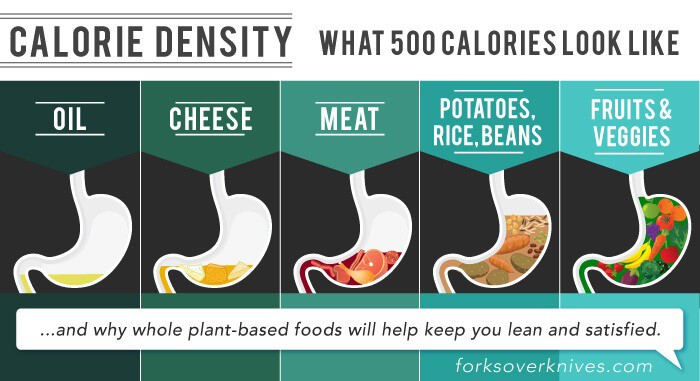
How nutrient density plays a role in satiety
Nutrient density is similar to calorie density, but instead of calories, you are measuring nutrients. And instead of using pounds as your reference point, you are using either 100kcals, 100 grams, or a serving size. According to an article supported by the NIH, this is the best definition we have for nutrient density at this point.
Essentially, nutrient density describes how much bang (nutrients) you are getting for your caloric buck per some amount of food. Dr. Fuhrman has some great references on the nutrient densities of specific foods. Check out the table below to get a feel for what types of foods are high in nutrients, and which ones are lacking.
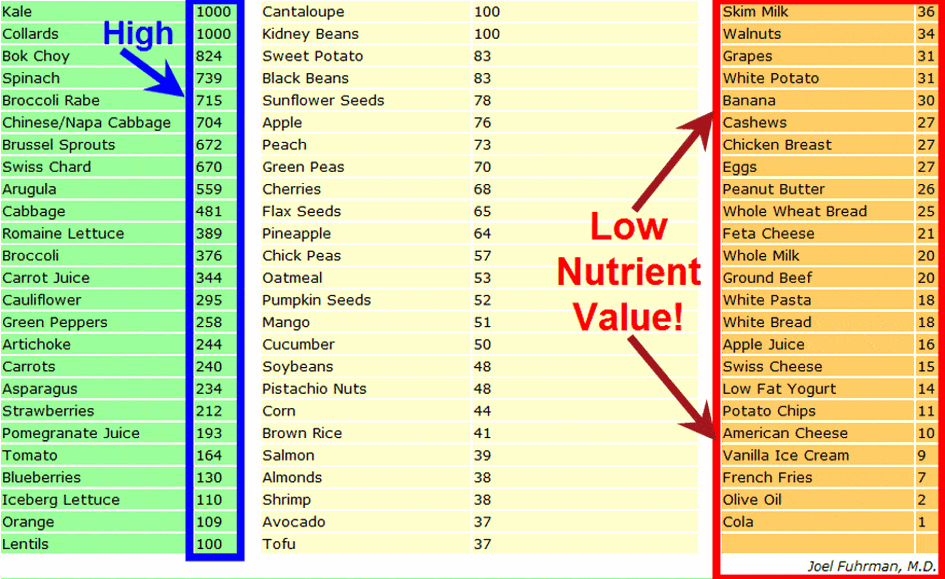
Why is nutrient density important for weight loss?
Remember the stretch receptors we went over earlier? Well, nutrient density is another method the body uses to determine how much food we still need to eat.
If you ate a giant bowl of vanilla ice cream, for instance, even though your stomach may feel full, your hunger signals are still firing because there are very few nutrients in vanilla ice cream.
When we eat foods with a high nutrient density, in addition to having a high volume of food, both our stretch receptors and our nutrient receptors signal to the brain that we are officially satiated and no longer require hunger signals. Our brain gets the message that we do not require more food at this point and shuts off the hunger signals.
So instead of eating a large bowl of vanilla ice cream, perhaps we eat a large bean burrito with cilantro, tomatoes, onions, guacamole, and rice. The burrito satisfies both our stretch receptors and our nutrient receptors.
Let’s go over a few more examples to get you started on the fastest road to healthy weight loss.
7-Day starter meal plan for plant-based weight loss
There are some very basic strategies laid out in the downloadable meal plan. Let’s take a look at the highlights to give you a better idea of how to plan your own healthy meals.
- Even though I have included breakfast, lunch, and dinner, there is no reason to eat a specific amount of times per day. You can eat two big meals or four smaller meals. It really depends on your hunger drive.
- Eat when you are hungry, not because it is a specific time of day, i.e. breakfast or lunchtime.
- It is perfectly acceptable to have savory foods for breakfast. Especially those that contain legumes, starches, and greens.
- Lunch or mid-day should typically be your largest meal of the day. Breakfast should be somewhat smaller, and dinner should be light and small.
- Always eat a salad once per day, typically for dinner. That way you get all those important micronutrients without going to bed with a heavy stomach full of food.
- Drink water for all, or at least most of your beverages.
- Try to include foods from the following categories each day: legumes, veggies, fruits, whole grains, nuts, and seeds, (only include nuts and seeds if you are not trying to lose weight).
- Include green leafy vegetables in most of your meals whenever possible.
- There is no reason to eat everything listed on the meal plan. If you find one or two dishes you absolutely love and find easy to make, then feel free to eat those all week.
- Have fun with this! It’s not about perfection. It’s about progress. Every little change is a step in the right direction. The more you practice this lifestyle, the easier it becomes.
I hope you have enjoyed this post! I had a lot of fun writing it. Stay tuned for more info and tips on plant-based weight loss.
Karli Jackson

